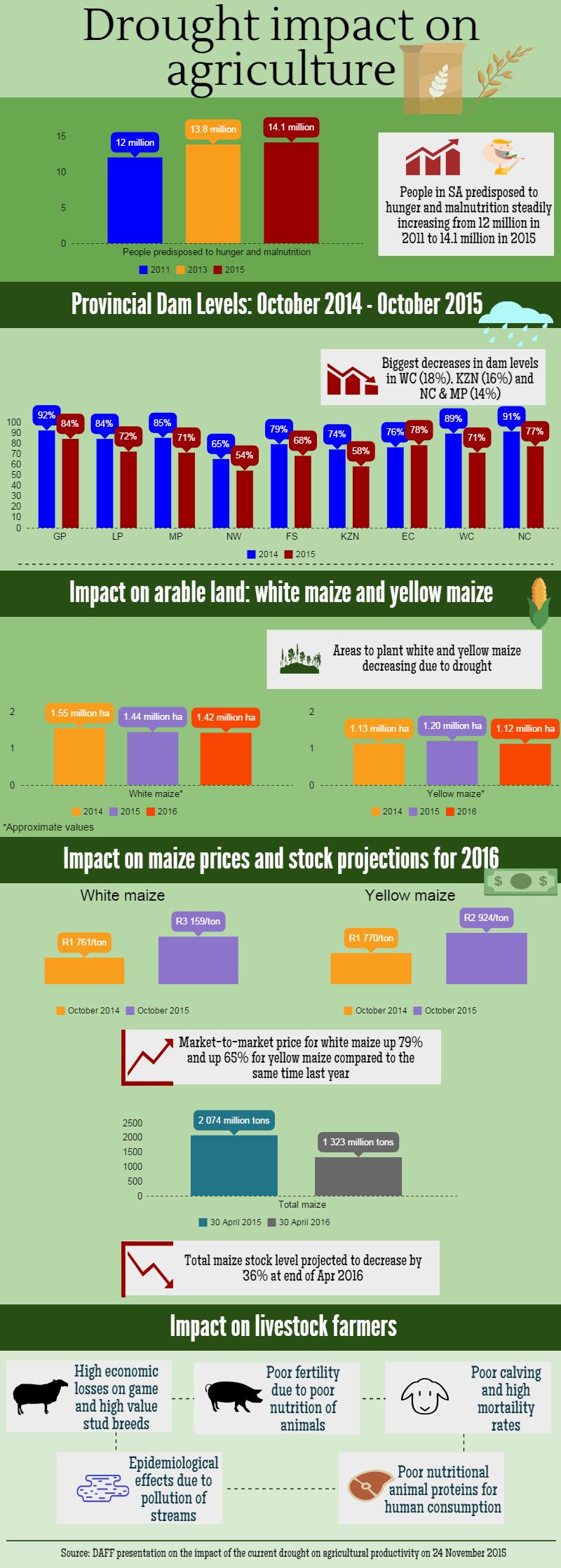See infographic below:

The agricultural sector is vital to many livelihoods and it is a source of employment in rural communities with a significant contribution to the Gross Domestic Product (GDP). Statistics SA notes that the sector contracted 17% quarter on quarter largely due to the 2015 drought conditions.
The Department of Agriculture, Forestry and Fisheries was meant to present an assessment of the impact of the current drought on agricultural productivity, sector employment and food costs, as well as give an update on the assistance given to farmers in drought-stricken areas on 24 November 2015. Protesting staff members disrupted the meeting shortly after it began, but the presentation gives an outline on the impact of the drought as well as on the interventions the department has planned and had already implemented.
The upward trend (12 million in 2011 to 14.1 million in 2015) of the South African population predisposed to hunger and malnutrition calls for actions to counter the situation. If South Africa has to consider importing produce such as maize and wheat, the global outlook is as follows:
-
World cereal production is currently forecast at 2 534 million tons – 24 million tons (0.9%) less than 2014
-
The latest forecast puts this year’s global coarse grains production at 1 306 million tons – 1.8% less than 2014
-
Global rice production would be 1.9 million tons – 0.4% lower than 2014
-
Wheat production is forecast at 735 million tons – slightly (0.3%) exceeding 2014
-
Higher wheat production in China and the European Union (EU) accounts for the upward trend
The grain industry contributes about 25% of agricultural GDP and South Africa is the largest maize producer in the Southern African Development Community (SADC) region with about 8 million tons of maize consumed in SA. The current drought decreased the country’s arable land and stock levels of both white and yellow maize are projected to decrease by 36% at end of April 2016. For white maize, South Africa has sufficient stock until end of April 2016, however the stock levels for yellow maize will be tight. At the same time the market-to-market price for white and yellow maize in October 2015 was up by 79% and 65% respectively compared to the same time in 2014.
Livestock farmers similarly are experiencing high economic losses especially on game and high value livestock stud breeds. There is a need to manage epidemiological effects of the drought to curb/prevent the outbreak of diseases due to pollution of streams. The Minister recently called on farmers to ‘unite against the drought crisis’ and he conceded that the “the almost inevitable need to import next year is likely to drive food prices up”. He addressed farmers in the Free State where certain areas had already been declared ‘drought stricken’ and assured farmers that the government was already re-prioritising funding and getting feed to where it is needed most.
To see details of the interventions to mitigate the effects of the drought see DAFF presentation here, as well as a previous infographic on drought management here.


Comments
Keep comments free of racism, sexism, homophobia and abusive language. People's Assembly reserves the right to delete and edit comments
(For newest comments first please choose 'Newest' from the 'Sort by' dropdown below.)